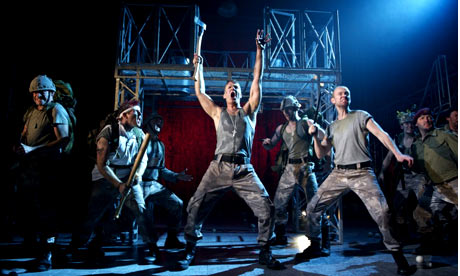If the thought of going to see a play by William Shakespeare fills you with the same amount of excitement as a visit to the dentist for root canal work, then you clearly haven’t seen it performed by Propeller Theatre Company.
Their all-male cast present Shakespeare in such a way, that each play is given an innovative and contemporary setting but without tainting the original text and its intricate and eloquent language. Never more so was this the case than in their current production of Henry V which is charged with machismo, emphasizing physical strength, aggression and courage – quite fitting when telling the tale of one of the greatest leaders and warriors in English history and at a time when there is much attention on our troops serving abroad in Afghanistan. The sight of so many men in uniform – all extremely physically fit following their military fitness training was also enough to appeal to all of the females in the audience too!
Henry V has proven to be very popular in the past with many great actors playing the title role including Sir Richard Burton, Sir Laurence Olivier and more recently Kenneth Branagh. With such acting giants as these previously playing the title role it might have been tempting to copy some of their qualities but Propeller, in their own inimitable style have produced a Henry V unlike any other. Not only do you get superb performances in the acting, but this cast also sing and play their own musical accompaniments - and move the scenery as they go!
The staging was cleverly done, making full use of every inch of the performance area and using several props repeatedly for different scenes. I particularly liked the use of large crate lids which became the ramps on the landing crafts – reminiscent of the beach landings in Normandy during World War 2. Several scenes were visually dramatic including the fight scenes when the stage was filled with smoke and flashing light but also in the more sombre scenes when just a torch or a flame lit the actors face. The music also played a huge part in this production whether performed on or off stage to compliment the many soliloquies. Written and arranged by cast members Gunnar Cauthery and Nicholas Asbury, the harmonies were exquisite and rousing which really helped to bring out the various emotions of the play. There were also occasions when the music helped to introduce some of the lighter hearted moments of the play and my only disappointment was that we didn't get a singing performance in the interval as had been done in previous years.
The whole ensemble worked brilliantly together, a true band of brothers from which you felt a great sense of camaraderie between them. Several members of the cast played more than one part which often required a quick change of costume (and character) in the wings but was achieved with a seamless ease. There were many standout performances including; John Dougall as the French King and Duke of York, Karl Davies as “the boy” and Princess Katherine - forming an amusing sort of double act with Chris Myles as lady in waiting Alice and Tony Bell as always adding some light hearted moments in his portrayal of Mistress Quickly and Fluellen (with a brilliant welsh accent)
Dugald Bruce-Lockhart added a new dimension to King Henry in that as well as being an inspiring leader and military hero, you also saw a softer more vulnerable side when seeking the approval of his men and when mourning the dead. His delivery of the famous St. Crispin’s day speech came across as heartfelt and sincere as well as quietly inspiring. Whilst other actors in the past have tended almost to shout out this speech as if addressing the entire audience as their troop, Dugald addressed his “happy few” in a much more sombre and quieter tone which made it feel more personal as though addressing a friend or brother and yet also gave a sense of the nervous anticipation felt at the thought of the impending battle. He also showed a great variety of emotion when seeing “the boy” dead, his sadness turned to anger and then when hearing of the number dead a softer, humbler side as he declared that God had fought with them that day. There was also an irresistible, boyish sort of charm about him as he set about wooing Katherine which made his character even more likeable and appealing.
Propeller knows how to push the boundaries without going too far and without detracting from the original text. If you’ve never had much time for the works of Shakespeare before, then seeing them perform will change your whole perception of them.
For more details of the Propeller Theatre Company and their current tour of Henry V and The Winter’s Tale go to http://propeller.org.uk/home







